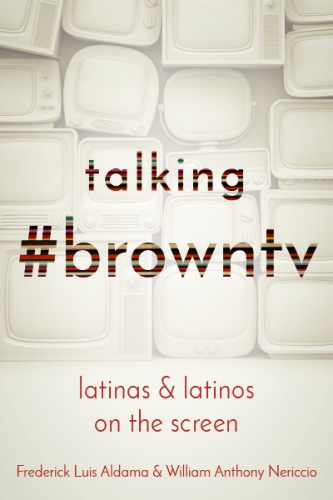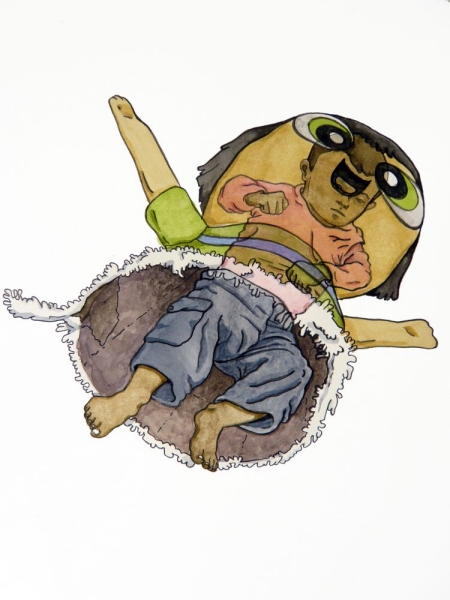
by Deborah Harris

Published by Ohio State University Press, 2019 | 2018 pages
One of the watercolors in Julio César Morales’s Undocumented Interventions series depicts a Powderpuff Girl piñata floating on a white background. The piñata is tipped back into empty space, and, from this vantage point, we can see that under its cardboard and paper skirt, it has a pair of legs depicted much more realistically than the piñata’s other limbs, which are stick straight arms stretched open into a perfect V. This disjuncture helps the viewer see that there are two bodies represented here—that of a cartoon character sculpted from paper, glue, and cardboard, and that of an actual child, whose torso we can glimpse through the semi-transparent piñata. The child looks calm, looks past us. While their face is mostly visible under the gaping black half-moon of the cartoon character’s mouth, its opacity creates a kind of hole in the child’s head. It is a potentially disturbing detail. Is there something seriously wrong with this picture? Is it right to read some serenity into it?

This watercolor is part of a series Morales made in order to engage with the realities of migration and border-crossing. In the series, the artist remediates photographs taken by Border Patrol agents. By transforming these, Morales has said he aims to reveal what may not be immediately apparent in the often heart-wrenching photos he works from—beauty, dignity, and humanity; he seeks to explore the manner in which the “wrong pictures” can turn out to be the “right” ones after all. If there is something unsettling about Morales’ watercolor of the child in the piñata, it is the manner in which it foregrounds contradictory values—humanity is shown hand in hand with inhumanity, peacefulness with violence.
Questions about the uncomfortably close relationship between the “wrong” and “right” pictures are also at the heart of Talking #browntv, a recent publication by Frederick Luis Aldama and William Anthony Nericcio. The book stages a wide-ranging conversation between two friends as they look back at the televisual history informing contemporary mediations of Latinidad. In their dialogue, Aldama and Nericcio take on topics both expected and unexpected. They discuss familiar, highly stereotypical depictions of Latinx subjects along the lines of Speedy Gonzalez, but they also make significant efforts to call the reader’s attention to small moments of Latinx representation hiding in plain sight, so to speak, in the Anglo American televisual archive. For instance, their discussion of a single, obscure episode of The Doris Day Show from 1968 spans three pages and includes five stills, while the broad strokes of J.Lo’s career as an actress are established in a few lines.
Talking #browntv suggests it is important to take into account both the well-known and the lesser-known instances of Latinx TV. Only with such a broad view, the book implies, will we be able to really address the question of what counts as a “good” or a “bad” representation of Latinx persons today—our contemporary images look different when they are historically contextualized in this manner. Instructively, Aldama and Nericcio take pains to establish the true complexity of any endeavor to evaluate Latinx representation in the mainstream media. They ask: What makes a televisual representation good in the first place? Is our perception of its goodness related to an apparent ability to spur the imaginations of Latinx viewers or does it have more to do with an attempt to address bias against them? And how do we take into account the way in which creative Latinxs transform bad representations into good ones? If unsatisfying representations require imaginative work, then isn’t that good in its own way?
These last questions are particularly close to the authors’ hearts; Aldama and Nericcio affirm the power of the Latinx viewer to turn “wrong” into “right” and insist on its significance. Throughout the book-length discussion, they draw on their own experiences as life-long consumers of US mass culture to argue that Latinx audiences have always been able to “metastasize” the trash they are offered in the mainstream. Even when only presented with the thinnest “slivers of brown worlds” in famously stereotypical content like the aforementioned Speedy Gonzalez cartoons, the authors hold that Latinxs can still exercise “our counterfactual capacity to extrapolate from our present (and past) and imagine a different tomorrow.” “No matter the diametric stereotype,” Aldama proclaims, “we as Latinxs are not passive, absorptive sponges…We distill and reconstruct in our own imaginations.” Thus, even Speedy’s obviously racist characterization, with its Ándales and Arribas and all, is potential fodder for the construction of a positive Latinx self-image. After all, the authors point out, Speedy is the “smartest and most agile” of his cartoon cohort—he is always a winner who triumphs over his enemies.
Some readers may find this emphasis on the agency of the consumer a bit excessive, but Talking #browntv presents a strong case for the need to revisit the lessons of Stuart Hall and the Birmingham school of cultural studies, whose writings have long encouraged us to consider ways in which the consumer might transform or renegotiate the message of mass cultural artifacts. As Aldama and Nericcio persuasively establish, such a vision of the agentive and inventive (Latinx) consumer is all too often abandoned in contemporary appraisals of Latinx representation in the US mainstream. They note that their undergraduate students have trouble reading complexity into mass cultural artifacts that contain racist content. Aldama speculates that it may be that with increased Latinx representation in the mainstream, younger generations have less incentive to “sleuth out brown complexity” in objectionable depictions—in the “wrong” pictures— than those who came of age in the mid- to late- twentieth century. Understandable as it is to be fed up with racist media, this interpretive attitude is not necessarily a happy turn of events, the authors warn: the urge to simply look away from “bad” representations can lead one to become complacent with flat and unimaginative depictions of Latinx subjects that do not challenge the viewer to perform her own creative operations.
Speculation about the origins of this lamentable interpretive trend aside, my own experience teaching televisual representations of Latinidad resonates with that of Aldama and Nericcio. Fortunately, Talking #browntv is highly instructive in this regard. Drawing on both authors’ memories of “sleuth[ing]” out reflections of themselves in twentieth century US mainstream culture, the book uses both images and text to construct a compelling archive of the modes of consumption that predate our contemporary ways of reading #browntv. Nericcio, for instance, shares images originally created for other projects—such as his Tex{t}-Mex Galleryblog—that celebrate the viewer as an integral part of the televisual landscape; in one, the author even seems to share the screen with Lynda Carter’s Wonder Woman.
The opening passage of Talking #browntv’s fourth section, “From Niños and Teens to Comidas,” contains Aldama’s description of going to his abuelita’s house as a child to sit on her “plastic covered couch” and watch Saturday morning cartoons on her TV. His narration is quickly interrupted by an image. A cutout photograph of the kind of “cathode ray beas[t] carved into a serious piece of oak furniture” that allowed the author to watch El Dorado on ABC’s The Super Friends (while slurping down Trix cereal) dominates the page.
Contemplating this image, one can almost feel the weight of the bulky—and iconic—appliance as it makes itself at home amidst the printed text, breaking it apart. The picture invites the reader to take a break from the flow of the prose, to try and place herself in an earlier time of life in which partial identification with the people appearing on TV—even cartoon super-people as sloppily constructed as El Dorado—may have been more easily accomplished, and even used as a starting point for fantastical reimaginings of the world. What could we see if we took a similar approach to the #browntv we encounter today? Would any of our “better” twenty-first century representations of Latinx subjects provide the same kind of rich imaginative fodder? Aldama and Nericcio certainly have their doubts. Talking #browntv suggests that it is sometimes the “wrong” pictures that we need the most. Imperfect images in the mass public sphere can spur us to throw off the mantle of the passive individual consumer. They can bring us together to discuss what mass culture affords and what it denies, moving us to continue to dream up new ways of communicating and sharing nuestras historias.
Carmen Merport Quiñones is a Postdoctoral Scholar at the University of Chicago in the Department of English. She writes about 20th and 21st century literature and visual culture and is particularly interested in exploring the ways identity emerges from images and text. Her work has appeared or is forthcoming in venues including PMLA, Criticism, Textual Practice, LARB, and Among Others: Blackness at MoMA, a recent publication of the Museum of Modern Art.















click to see who
MAKE Magazine Publisher MAKE Literary Productions Managing Editor Chamandeep Bains Assistant Managing Editor and Web Editor Kenneth Guay Fiction Editor Kamilah Foreman Nonfiction Editor Jessica Anne Poetry Editor Joel Craig Intercambio Poetry Editor Daniel Borzutzky Intercambio Prose Editor Brenda Lozano Latin American Art Portfolio Editor Alejandro Almanza Pereda Reviews Editor Mark Molloy Portfolio Art Editor Sarah Kramer Creative Director Joshua Hauth, Hauthwares Webmaster Johnathan Crawford Proofreader/Copy Editor Sarah Kramer Associate Fiction Editors LC Fiore, Jim Kourlas, Kerstin Schaars Contributing Editors Kyle Beachy, Steffi Drewes, Katie Geha, Kathleen Rooney Social Media Coordinator Jennifer De Poorter
MAKE Literary Productions, NFP Co-directors, Sarah Dodson and Joel Craig